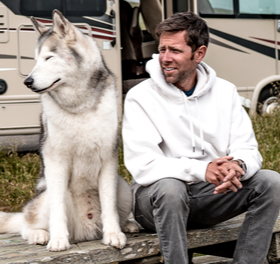What to See and Do
Hiking and Biking
Mohave Milltown Trail
This BLM trail has hikers and bicyclists riding on an old railroad grade. Sometimes, the grade disappears, and you have to detour due to past flooding in the area. Signs and rock cairns (piles of rocks) guide your way. If you want to see the desert wildflowers, they tend to bloom from February through April. The wildflower show is best in years with better rainfall.
Length: 7 miles
Intensity: Easy
Wabayuma Peak Trail
The trail takes you up to Wabayuma Peak. The hike begins on a Jeep road but will take you up to the saddle for a bit of cross-country travel. For a while, you are in tall ponderosa pine trees. The views include mountain ranges in each of the cardinal directions.
Length: 2.5 miles
Intensity: Moderate
Mexican Hat Trail
Located in the Turtle Mountains Wilderness, this is a tiny portion of a trail that took travelers to the Colorado River. It is an uphill slog. In the area is the Lost Arch Historic Mining Camp. This is a great area for photography, with historic mining relics and floral cacti displays.
Length: Unknown
Intensity: Strenuous
Cupcake Mountain Hiking Trail
This trail takes you to the top of Cupcake Mountain that has an overlook of Lake Havasu. The mountain is in the Whipple Mountains Wilderness Area.
Length: 5 miles out and back
Intensity: Strenuous
Twin Springs Trail
Located in the Mt. Nutt Wilderness, the Twin Springs Trail takes you in the direction of its namesake springs. This area has volcanic and lava deposits that have created caves and spires to explore. You will see wild burros and cattle in the area. Mountain bikes are prohibited, since the trail proceeds into designated wilderness land.
Length: 1.4 miles is the trail length. Getting to the springs is an unknown distance farther.
Intensity: Easy on the trail. More strenuous adventures take you up to the springs and farther explorations in the Black Mountains.
Fishing and Boating
Fishing and boating opportunities abound, as well as paddle boarding, swimming, kayaking, and inner tubing. The day use area is in close proximity to the Colorado River and Goose Lake. Lake Havasu is only 50 miles away.
Climbing
Although there are no designated climbing spots in the area, the Black Mountains in the Mt. Nutt Wilderness with their volcanic spires may be inviting. The Twin Springs Trail is the entrance to this area.
Wildlife Viewing
In the local area, you will see coyote, jack rabbits, kangaroo rats, bighorn sheep, golden eagles, falcons, roadrunners, desert tortoises, wild burros, antelope squirrels, chuckwallas, mourning doves, California quail, and lizards. You will also see tarantulas, ravens, bats, vultures, horned and black-collared lizards, mountain kingsnakes, and rattlesnakes. Good places for wildlife viewing include Chalk Hills and West Well, which has a wildlife watering guzzler in place. Also, you can go to the Twin Springs Trail to see the burros and cows as well as to the Monkeyhead Flat Wildlife Viewing Area which is on the California side of the Colorado River.
Picnicking
There are two picnic tables at the day use area, but many people will likely go for a picnic at the nearby Colorado River or at either Goose Lake or Lake Havasu. Lake Havasu has grills as well as picnic tables at the BLM sites.
Horseback Riding
The Mohave Milltown Trail is also an equestrian trail, but equestrians and ORV riders ride below the railroad grade following a parallel trail that crosses the railroad grade at times. The Wabayuma Peak Trail is extremely difficult for equestrians, but the BLM permits horseback riding on this trail.
Off-Road Vehicle Riding
Besides the Mohave Milltown East Motorized Trailhead, there is also a designated ORV site at the Chemehuevi Wash ORV area, but little details about the area exist. It is known that there are motorcycle trails there.





